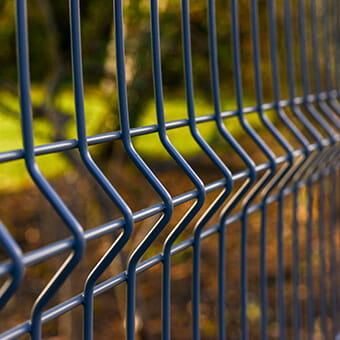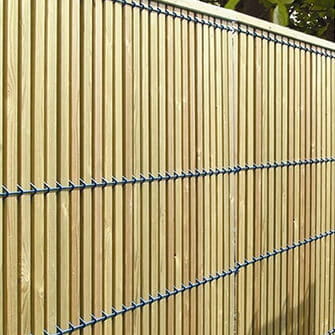Our other sites:
Football is the most popular sport in the UK, with over 45% of people tuning into games on TV, and over 11 million people participating in the sport across the UK. As well as the professional leagues and divisions, there are grassroots clubs, school clubs, social clubs, and semi-professional clubs, all with their own or shared football training grounds.
- Security measures in football clubs
- Integrated security model
- Key areas for security consideration
- Perimeter security
- Effective access control
- Extending security beyond training grounds
In the past, sports clubs and football pitches generally required ball stop fencing to prevent footballs leaving the grounds or damaging nearby property, with some demarcation fencing around the perimeter. Nowadays, it is common for clubs to have security fencing and gates, with elite clubs having multiple layers of security measures. For clubs to be able to compete in the FA league, there are also certain ground grading requirements. Over the last decade, players in various sports -– particularly in the elite level football clubs – have become more like celebrities. With the increase in money injected into higher league football, security and safety is now high on the agenda.
In recent years, there have been reports of clubs spying on each other to gain insight into their training techniques and practices. There have also been reports of angry fans breaking through the perimeter of the training ground and confronting players and managers.
The press and journalists outside the clubs will take any opportunity to gain photos of individuals within the team who have any kind of speculation around players. All of the above can cause distractions and even anxiety for the team while training, potentially losing games worth millions of pounds in revenue to the club.
For community clubs, vandalism is a common issue, whether it is directly linked to sabotaging a team’s chances or not.
Depending on what type of training ground you are specifying for, here are some general guidelines for a sports facility and some combinations that are commonly used.

An overview of the 5Ds
The 5 Ds model of integrated security can be applied to any property or site that requires protection. Deter, detect, deny, delay, and defend make up the layers, with various measures implemented for each ‘D’ to build a robust strategy, such as fencing, gates, CCTV, PIDS, alarms, and security personnel. Whether you are specifying for a community club or elite club, the same principles apply, but the levels of security may change for each product, such as the type of fencing.
Location
Some training grounds are located in highly remote areas, where rural crime risks may apply. Groundskeeping equipment may be a target of theft so it pays to ensure this is kept in a secure area or compound. We recommend that expensive machinery is kept in compounds surrounded by low visibility fencing such as EuroGuard® Combi or Jakoustic® barriers, to keep them out of sight. Both are available with LPS 1175 ratings to provide certified protection against attempts at forced entry. If these items are kept in buildings, the perimeter fence should be protected against panels being removed to create gaps to get equipment and vehicles out.
Again, if the training ground is located in an urban area or parallel to a busy road, privacy and security is key and this is where perimeter solutions specifically designed to enhance privacy should be used.
Areas to consider:
Perimeter security
The perimeter of a training ground should be secured by fencing that is at least 2 metres high with matching gates to enable vehicular and also pedestrian access.
Depending on where the pitches are in relation to public access, you may need privacy fencing around the perimeter to protect players and prevent spying. This will not only stop spying and distractions but deter people from walking the perimeter and trying to get a glimpse of players, which could potentially lead to further problems such as people congregating outside the perimeter shouting abuse, throwing objects, trying to gain access, or potentially more dangerous threats.
Jakoustic® acoustic barriers help to achieve privacy while also reducing noise, which helps to keep training under wraps and keeps neighbours happy. Acoustic barriers can be installed up to any height required (with permission) and have no hand or foot holds, providing robust security.
Anti-climb mesh fencing is also popular when layered with ball stop netting pitch side, while vertical bar or ornamental railings and gates provide a grand appearance which works well around site entrances.
Access control
For community clubs, a manual double leaf gate provides convenient access and enables emergency and maintenance vehicles space to come on site when required. Having a manual gate reduces maintenance costs.
Larger clubs may have multiple entrances and exits. Sliding gates are a popular option as they provide good levels of security and offer quiet operation. Various access control devices can be paired with our automated gates to provide convenient access control.
Adding a measure which delays and slows down access is ideal for larger clubs. A rising arm barrier or automated bollards work well with manned security to perform checks and grant access.
Outside the training ground
The safety and security of players does not end at the training ground gates. Unfortunately, as is common with celebrities, there have been incidents involving footballer’s homes; home security is also important. We discuss high value property security here.
In addition, stadiums have their own set of complex security problems. Read more about stadium fencing solutions here.
Related products
Jacksons Security has a range of products relating to this article, all complete with our 25 year service life guarantee. If you cannot find the item you are looking for, please do not hesitate to call our friendly sales team.
Related Content
Top








